Train Orders
January 7, 2002
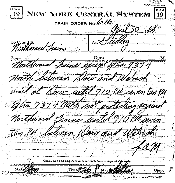 Train orders came into being trying to keep opposing trains from occupying a piece of
track at the same time. As long as all the trains were going in the same direction there
were few problems. As traffic increased, trains were required to run at the same time in
opposite directions. To overcome this problem, different solutions were tried, but a
timetable schedule seemed to be the best bet. With the timetable, times at stations
and sidings, were printed in the timetable with meets with other trains. Now the
problem was, who takes siding or who is the superior train. As an example, two
passenger trains were meeting at siding X. Who takes siding? Making one train
superior solved that problem but created another. If a passenger train, in the inferior
timetable direction, meets a local freight at siding X, then according to the directional
superiority, the passenger train would take the siding. The superintendent and the
passengers would not like this. To correct this, they divided trains into class, passenger
trains first class, fast freight second class, third class, fourth class and so on, for the
number of classes the railroad might need. In a 1913 timetable, the Michigan Division
(NYC) had four classes of trains.
Train orders came into being trying to keep opposing trains from occupying a piece of
track at the same time. As long as all the trains were going in the same direction there
were few problems. As traffic increased, trains were required to run at the same time in
opposite directions. To overcome this problem, different solutions were tried, but a
timetable schedule seemed to be the best bet. With the timetable, times at stations
and sidings, were printed in the timetable with meets with other trains. Now the
problem was, who takes siding or who is the superior train. As an example, two
passenger trains were meeting at siding X. Who takes siding? Making one train
superior solved that problem but created another. If a passenger train, in the inferior
timetable direction, meets a local freight at siding X, then according to the directional
superiority, the passenger train would take the siding. The superintendent and the
passengers would not like this. To correct this, they divided trains into class, passenger
trains first class, fast freight second class, third class, fourth class and so on, for the
number of classes the railroad might need. In a 1913 timetable, the Michigan Division
(NYC) had four classes of trains.
Now that we can move trains against each other and trains can follow each other, what are
we going to do when a schedule is not in effect. A schedule is in effect for twelve hours
at any point where time is given. You might want to run an extra train and cannot fit
it into a schedule. The answer to this is train orders.
In the book of rules, trains are superior by right, class or direction. I always instructed
the younger people to remember this in the above order for this reason. Right is first
because it is given by train order. It is current and can supercede the timetable or other
train orders. Extra trains were superior by timetable direction. Timetable instructions
said on the Michigan, the superior direction of trains is north. The word trains covers
all northbound trains, scheduled and extra. Sometime between 1913 and 1937 the
timetable instructions started reading, northward trains are superior to southward trains
of the same class. This leaves the extra train out because extra is not a class. The
B&O Railroad used this method but their rules stated that meet orders must state
which train takes siding. A note in the train order examples in the Penn Central book
of rules stated, the superior train must be mentioned first in the train order.
The 1937, 1956 NYC and the 1968 PC rule S88 states, at meeting points between extra
trains, the train in the inferior timetable direction must take the siding unless otherwise
provided. The three words, unless otherwise provided, covers many things in the
book of rules. You must always determine what otherwise provided means in each case.
Rule 208 takes care of some of the otherwise provided, which says in part, when not
sent simultaneously to all, the order must be sent first to the superior train. And
another place, the several addresses must be in the order of superiority of trains.
Train orders are in effect until fulfilled, superceded or annulled. As with timetable
superiority, right, class and direction, train orders also have a reason to be fulfulled,
superceded or annulled. When a dispatcher puts out an order, he expects it to be
fulfulled or completed. He may have to supercede an order. This would usually
consist of changing the location of a meet with another train. The last thing the
dispatcher would want to do would be to annul an order. If he thought the order
would be annulled, it would not have been issued.
We are going to illustrate and describe several forms of train orders that were used
on the Michigan Division between So. Anderson and Elkhart. At this time we did
not operate under block rules except between Dow and South Anderson. The track
from Dow to Goshen operated by timetable and train order. We called it non-block.
Other railroads called it the dark railroad.
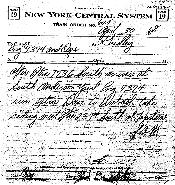 Click for larger view of order 615 Click for larger view of order 615
We are going to start with three orders for a train running from South Anderson to
Wabash and return to South Anderson. We start with order number 615. Notice the
order is addressed to engine 7374 and operator. The 7374 will not be an extra until
the arrival of extra 1736 south. At the meeting point, because the northbound is
superior by direction and the dispatcher wants the 7374 to take siding, he directs him
to take siding in the order. If you have a book of rules 1937, 1956 NYC or 1968 PC
rules, rule 208 covers the after part of the order because northbound trains must
receive form A at South Anderson. This order is a textbook order. It is a perfect
example of an after order in extra trains and reversing superiority at the meeting point.
 Click for larger view of order 616 Click for larger view of order 616
This train will do work from Dow to Wabash. At different locations, all the trainmen
will be at the head end switching. This leaves no one protecting the rear end of the
train. A protection order is issued. Order 616 is an example of this order. It is to
the point, clear and the time clear. The dispatcher could modify the order if conditions
dictated after the 1968 PC rule book was in effect. Until supplement No. 1, effective
Oct. 25, 1964, the NYC book of rules did not have an example of a protection order.
The company tried to use a time order form S-E as a protection order, but the
conductors at South Anderson refused the order form S-E because it did not state
that the crew did not have to protect the rear of the train. They were correct and
from this came the protection order. This is not to say this one division brought
this about but the combination of the many non-block divisions that knew this order
was needed.
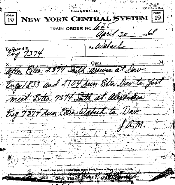 Click for larger view of order 625 Click for larger view of order 625
The 7374 arrives at Wabash, puts their train away and makes up the train for the
southbound trip. After eating the crew is ready to return to South Anderson. The
operator, Kellams, has the order, the form A and any work to do on the trip south.
Order 625 is almost a reverse of the order the 7374 had at South Anderson. I
will point out the difference between order 615 and 625 and the reasons why.
The 2374 in order 625 is the same train the 7374 took siding for at LaFontaine,
reversing superiority because the 2374 had a train longer than the siding. The
running order and meet order for the 1833 and 2104 comes next. The running order
takes both trains from Anderson to Goshen and the meet is what we called a
straight meet. North being the superior timetable direction, the 1833 and 2104
will hold the main at Alex. Last comes the running orders for the 7374.
- Train Order 640 and its Form A -
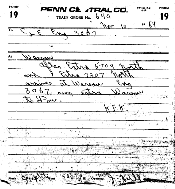 - Click either image to see the larger - - Click either image to see the larger - 
These orders , with the exception of an order form P, named superceding
order, with slight variations, covered most of the operations on the
Michigan Division for freight trains. A superceding order was used
mainly to change meets when for some reason one train fell behind.
Order No. 640 with its form A, is another good example of train orders.
There is more behind this order than we will bring out in a letter
story.
 Click for larger view of order 303 Click for larger view of order 303
Order 303 is a good example of a work train order. This order was issued at
Ekhart. BC is the name of the train order office at Elkhart Yards. This order was
probably one of two or three orders a southbound had leaving Elkhart. The order is
straight forward and to the point. One thing to notice is the protection against extra 7956.
If the extra passes the work extra at 9:15 am, then the work extra will not protect
against northward trains until 1:30 pm. After this time the work extra must protect
against both northward and southward trains. This would be an impossible chore
today with one man ground crew.
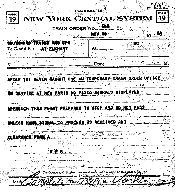 Click for larger view of 606 Click for larger view of 606
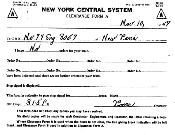 Sometimes a temporary train order office is put into service to better control a piece
of track. I don't remember why this order was issued but probably to let trains
depart Elkhart and still let a local or work train work between Warsaw and New Paris.
Order 606 puts the train order office in effect at 7:01 am but notice there is not a
closing time. It could be in effect continuously. A train order office cannot be closed
without the dispatcher's permission, rule 226 in NYC 1956 and PC 1968 book of rules.
The form A dated Nov. 10th, was what was given no. 77 per order 606 at New Paris. Sometimes a temporary train order office is put into service to better control a piece
of track. I don't remember why this order was issued but probably to let trains
depart Elkhart and still let a local or work train work between Warsaw and New Paris.
Order 606 puts the train order office in effect at 7:01 am but notice there is not a
closing time. It could be in effect continuously. A train order office cannot be closed
without the dispatcher's permission, rule 226 in NYC 1956 and PC 1968 book of rules.
The form A dated Nov. 10th, was what was given no. 77 per order 606 at New Paris.
With Traffic Control System in place from Marion to Goshen in the mid to late 70's and
the PRR manual block system between Dow and Marion at about the same time, the
days of operating with train orders had passed on the Michigan Division.
Maurice Lewman
Maurice worked the Michigan Division from 1947-1981. He then worked on the Bee Line from 1981-1992. From 1947 until august 1950, he worked on the section at Shirley and Markleville. In 1950 he started firing on steam and then on through the diesels. Maurice said, "I had the pleasure of working with C. C. Staley and Ron Buser many times."
|

 Train orders came into being trying to keep opposing trains from occupying a piece of
track at the same time. As long as all the trains were going in the same direction there
were few problems. As traffic increased, trains were required to run at the same time in
opposite directions. To overcome this problem, different solutions were tried, but a
timetable schedule seemed to be the best bet. With the timetable, times at stations
and sidings, were printed in the timetable with meets with other trains. Now the
problem was, who takes siding or who is the superior train. As an example, two
passenger trains were meeting at siding X. Who takes siding? Making one train
superior solved that problem but created another. If a passenger train, in the inferior
timetable direction, meets a local freight at siding X, then according to the directional
superiority, the passenger train would take the siding. The superintendent and the
passengers would not like this. To correct this, they divided trains into class, passenger
trains first class, fast freight second class, third class, fourth class and so on, for the
number of classes the railroad might need. In a 1913 timetable, the Michigan Division
(NYC) had four classes of trains.
Train orders came into being trying to keep opposing trains from occupying a piece of
track at the same time. As long as all the trains were going in the same direction there
were few problems. As traffic increased, trains were required to run at the same time in
opposite directions. To overcome this problem, different solutions were tried, but a
timetable schedule seemed to be the best bet. With the timetable, times at stations
and sidings, were printed in the timetable with meets with other trains. Now the
problem was, who takes siding or who is the superior train. As an example, two
passenger trains were meeting at siding X. Who takes siding? Making one train
superior solved that problem but created another. If a passenger train, in the inferior
timetable direction, meets a local freight at siding X, then according to the directional
superiority, the passenger train would take the siding. The superintendent and the
passengers would not like this. To correct this, they divided trains into class, passenger
trains first class, fast freight second class, third class, fourth class and so on, for the
number of classes the railroad might need. In a 1913 timetable, the Michigan Division
(NYC) had four classes of trains.






